Ever since the Papanui Parallel cycleway was created, it’s been a really useful way to get to the central city from the northern suburbs. There’s just been one problem: once you are south of Bealey Ave there has been no appealing way to ride further in for those less confident riders. Colombo St, while not the busiest of routes, is still not entirely friendly with a lack of cycle facilities on a 50km/h street.
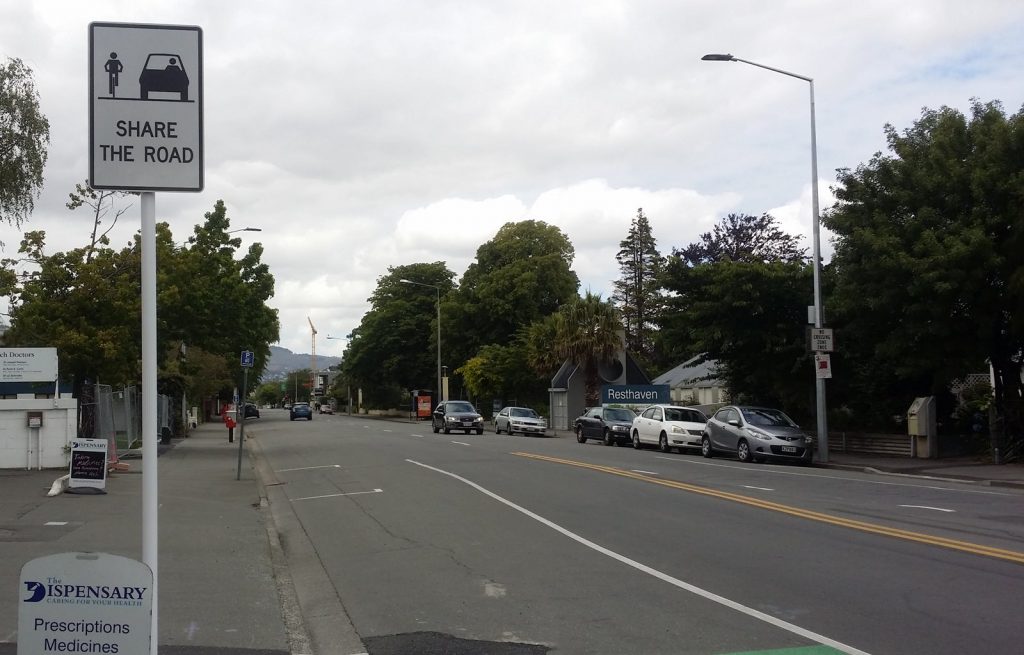
This is a problem common to most of the Major Cycle Routes coming into the city, largely stemming from the sections within the Four Avenues being historically managed by Ōtākaro after the quakes, rather than Chch City Council. Fortunately, this issue is now being addressed with a series of interim cycleway links (now revived in the final 2020 Annual Plan), and currently out for consultation is the section of northern Colombo St from Bealey Ave to the Avon River.
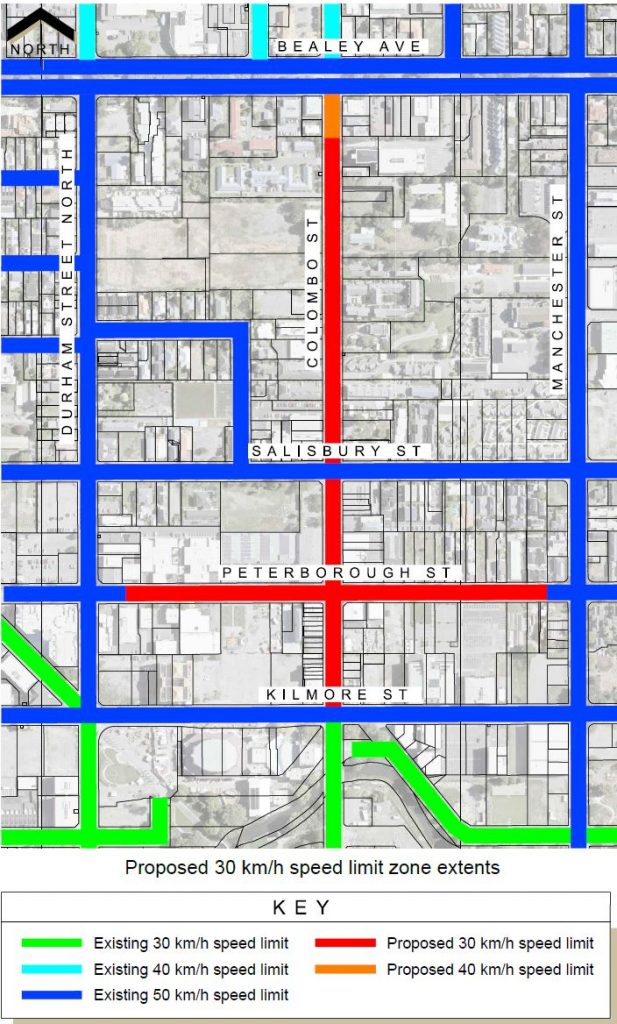
The proposed treatment is an interesting hybrid of a traffic-calmed street with buffered cycle lanes. With very few kerb changes, this is likely to be a relatively inexpensive interim treatment until more major street reconstruction is done in the future.
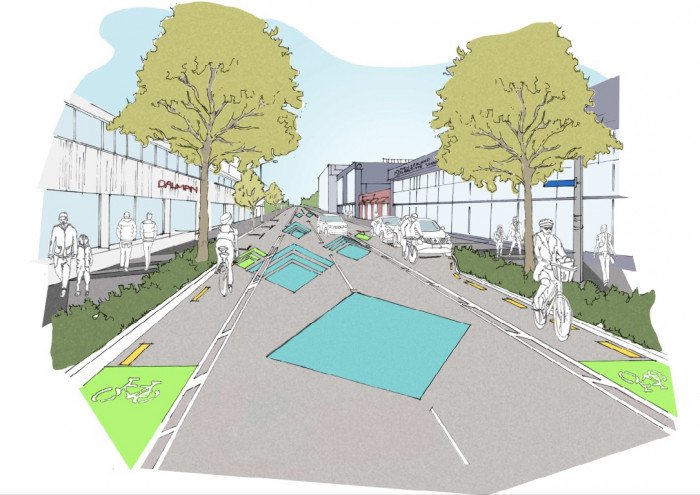
Key to it working is to have a lower speed limit (30km/h) with street measures that also encourage lower traffic speeds (BTW, I’m not really sure why there is a silly short length of 40km/h before you hit the 50km/h of Bealey – just make it all 30k). To do that, the Council are proposing some intriguing “roadway art” markings that (thanks to a recent Rule change) are allowed to be used on low-speed streets, together with some new trees in planter boxes.
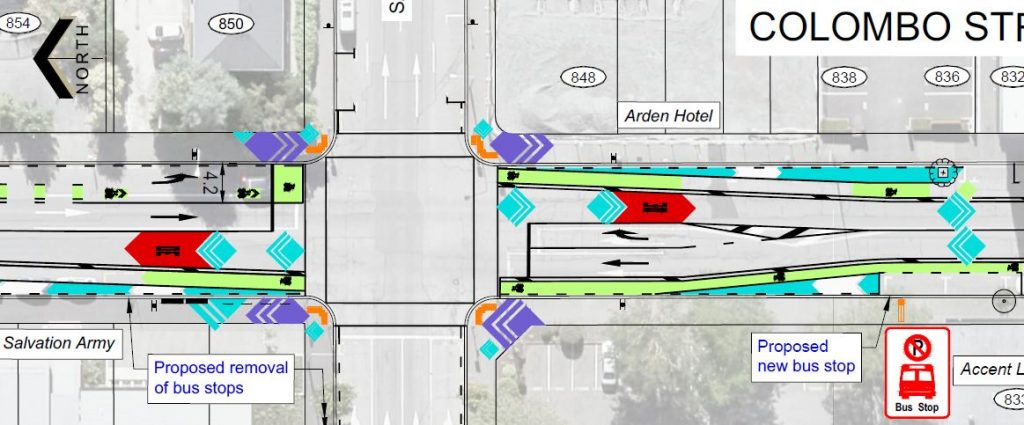
Painted cycle lanes are proposed for Colombo St, with buffer space against the traffic lanes. I know that some people will grumble about the use of non-separated cycle lanes, but that’s a reasonable option for 6000 vehicles/day at 30km/h (certainly better than the non-event at present…). Where I have a bit of a problem is with the proposed cycle lane widths next to car parking – 1.5m is not enough (it also goes against the latest national guidance on buffered cycle lanes). If anything, steal a few more cms back from the buffer space and traffic lanes (ironically, the average person worries more about the danger from passing cars when in fact it’s the parked car doors you should be more concerned about…).

Of course, the problem could done away with if car parking could be removed from even one side. But at the moment that is a bridge too far, and even the current proposal does see 32 of the current 109 carparks along this street being removed to fit in kerb extensions and street trees. Not surprisingly, that raised the hackles of many commentators (and brought out the usual anti-cycling diatribes) when the media duly reported on it recently.
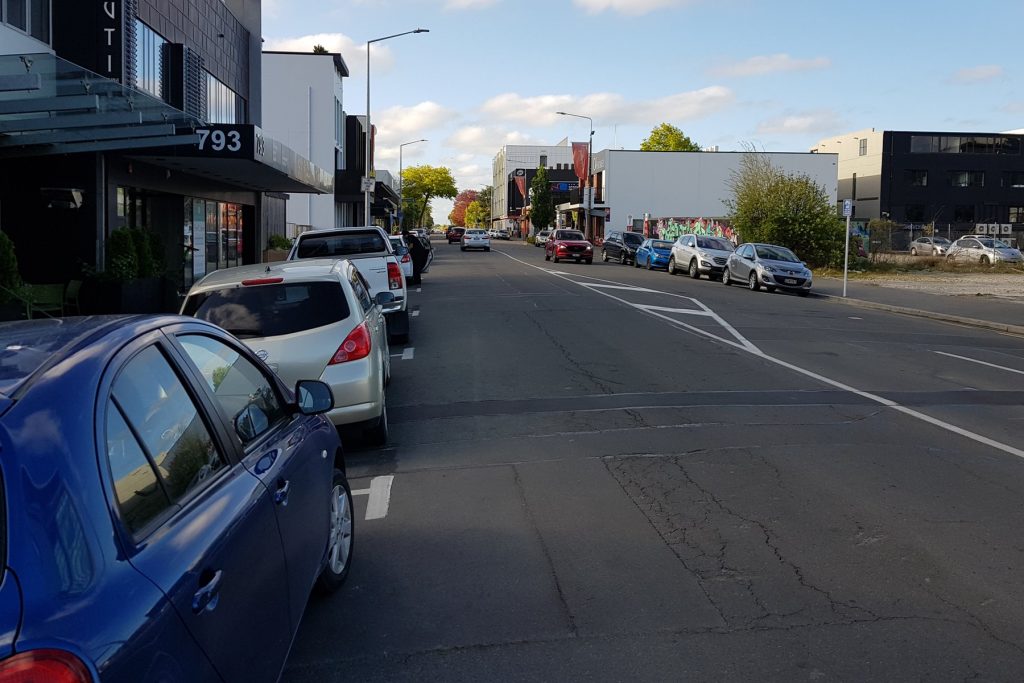
At the southern end, the cycle route will connect with the existing slow section of Colombo St south of the Avon River, as well as the lovely Promenade cycleway going along the river. The connections at this end are a bit non-intuitive though; it’s certainly not clear how you would get from the shared path on the east side to the cycle lane going north for example.

So overall, the proposal is a reasonable offering (and quite an interesting trial of street markings) but it does need to think a little bit more about the dimensions being used for comfortable cycle lanes.
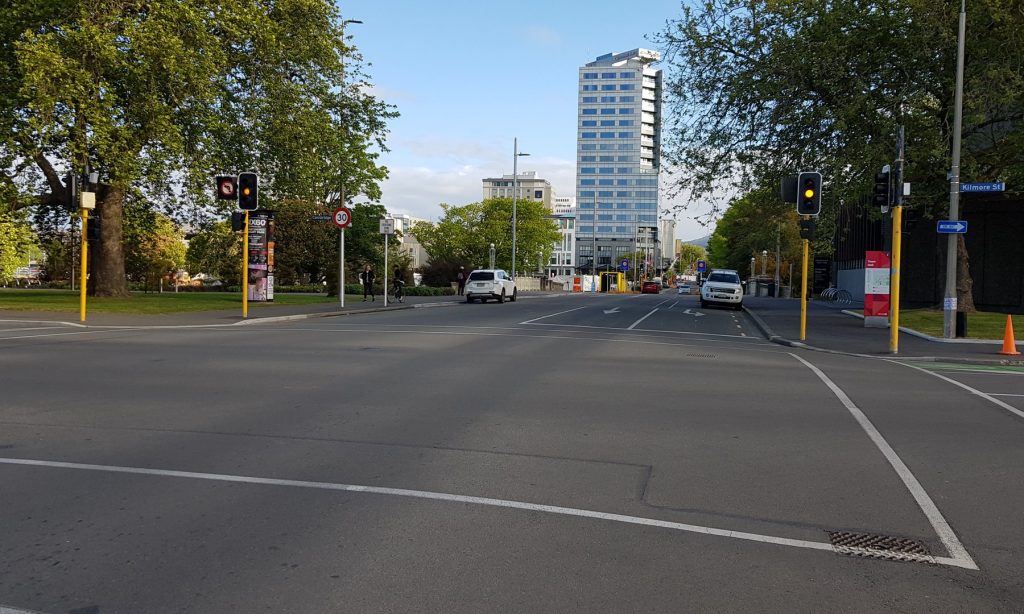
You’ve got just on a week to get your thoughts in on this, with feedback due by next Tue 27th Oct. Given a few likely naysayers grumbling about car parking, it will be good to get many people also indicating their support, even if there are a few details that could do with improving.
What do you think of the proposed street treatment for Colombo St nth?

When I first heard about this proposal I thought “this sounds like a reasonable quick and easy solution”. Then I tried the new painted cycle lanes on the rebuilt section of Hereford St and my concerns grew significantly. Squeezed in between the parked car door zone and general traffic did not feel like a safe place to be, even on a street slowed to 30 km/hr. How long would this “temporary” solution be locked in for?
Kia ora,
With regards to the cross section dimensions:
1) How narrow can vehicle lanes that take buses be?
2) How do these compare to other buffered cycle lanes across the city (e.g. Tuam St east of Madras, Manchester just north of the Avon)?
3) Is there a standard width for the buffer for it to be effective? I was reading the NZTA guidelines yesterday.
4) Would including the buffer in the width of the cycle lane (so there is no painted buffer) encourage drivers to pass too closely as they do in all other cycle lanes?
5) What treatment encourages the safest road placement for both cyclists and drivers?
Thanks
Interesting to hear your feedback Chris about Hereford St; I haven’t had a chance to ride there yet. I would note that the old (pre-quake) Hereford St cross-section had no cycle lane and so you were generally stuck in the middle of slow-moving traffic – often quicker to get off and walk. At various points in the development of the rebuilt street, a similar option was also on the table but the decision was made to provide separate bike lanes to get around that issue (those cycle lanes should be 1.8m too, by the way).
There doesn’t appear to be too much information in the plans ( nor referred to here ) about the Bealey Avenue intersection, specifically protecting cyclists from left turn traffic when heading north. Keeping vehicles from straddling the cycle lane should be considered also. Then there is the confusing and inconsistent for all users ( for no apparent reason, but I’m sure there must be one ) use of the left turning arrow. Thoughts anyone ?
The consultation plans say that “no physical changes are proposed to the Bealey intersection”, but I think it’s worth asking the question of whether that’s good enough. Given that the north side of this intersection already has a cyclist signal phase protected from turning traffic, the same phase could be used for southside bikes too. Alternatively (if new signals are too much hassle/cost), put the cycle lane between a left-turn lane and a through/right lane to avoid the problem of turning traffic.
It does occur to me too that this “paint-only” street treatment could be enhanced by a few strategically placed flexi-posts in the buffer space, e.g. next to the lefthand cycle lane leading up to Bealey, as well on some of the lane taper sections and in front of some of the new planter boxes and kerb extensions. That avoids blocking driveways or parking bays, but gives a slightly better feel of a “separated cycleway”.
Flexi posts are a waste of time. They get broken off quickly, maybe dent a couple of bumpers, and that’s it. Look at the ones on North Parade – you can’t because they lasted a week max.
Over time, I expect Christchurch will end up like Australian cities, where on-street parking goes away in the CBD and arterial roads, and we end up with two traffic lanes each way with no space for anything else.